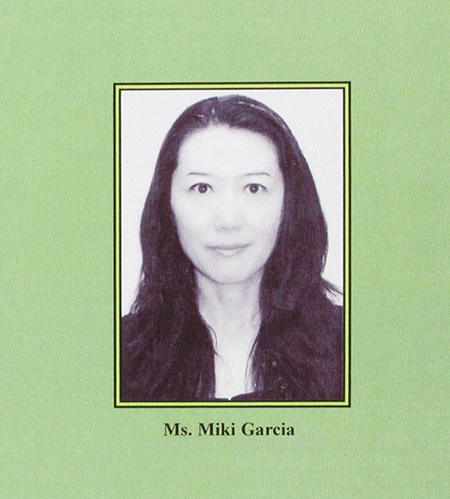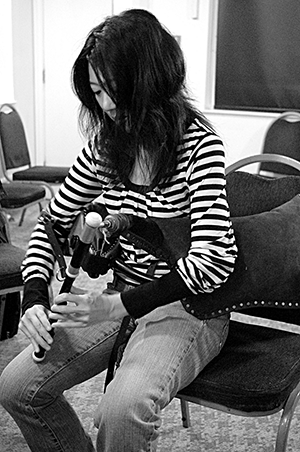Miki Garcia
A London Irish Story as told to Matthew Dunne-Miles
“I moved to London from France in the mid-1990s. Almost 30 years ago, time flies. I was surrounded by Irish people – classmates, housemates, flatmates, landlords, landladies, and neighbours.”
“I am Dutch and have Japanese heritage. I have lived in the United States, Canada, Dublin, Tokyo, Hong Kong, Bangkok, Thailand, and the Philippines. I’ve worked in many African countries. I went to school in France and the UK. I speak different languages. I really feel that I am a “global citizen”.
But home is really London. I have worked in other places, but I always come back to London. I'm a Londoner. I identify myself with London – Hammersmith to be precise.
I honestly believe I was put in Hammersmith by an invisible power!
In 1995, the Irish Cultural Centre opened in Hammersmith, and I took every single class and lesson there. I learnt to play the bodhrán, the tin whistle, and the Uilleann pipes. I learned everything at the Irish centre. There was an Irish library and I used to borrow Irish books all the time. I was there at the weekends as well for the sessions, céilí and I was watching GAA matches. I immersed myself in order to understand the history, the culture, and all the rest. I think I got carried away. I just couldn't stop.
I moved to London from France in the mid-1990s. Almost 30 years ago, time flies. I was surrounded by Irish people – classmates, housemates, flatmates, landlords, landladies, and neighbours. In the 1990s we didn't have a Paddy's Day festival in London. There were still bombings occasionally and what I noticed was how the British media were reporting this. I also came across a lot of homeless Irish people in the Kings Cross area, while I volunteered for a human rights charity. Those events were enough for me to dive into Irish culture and history. I started studying.
“I learnt to play the bodhrán, the tin whistle, and the Uilleann pipes. I learned everything at the Irish centre.
I immersed myself in order to understand the history, the culture, and all the rest. I think I got carried away. I just couldn't stop.”
I’m a journalist by profession and I've been writing since early in my early twenties. Irish history is not taught in England, Europe, or anywhere in the world. It’s kind of a mystery. I always wanted to write books anyway as a writer, so it was a natural process. It’s very important to be informed.
I wrote Rebuilding London: Irish Migrants in Post-War Britain based on my own experience and what I heard initially. I was at the Irish Centre all the time in the late 90s and there were quite a few 1950s and 60s immigrants. I was always asking questions like ‘which dancehall did you used to go to?’
The stories of the homeless people I met were really heart-breaking. A lot were from the countryside, and they were youngsters. They didn't know what to do, how to live, and the discrimination was quite common at the time. It was not a nice place to live in. I got a bit traumatised because I got to know them personally. The Irish government and British government didn't help them when they were the backbone of the British and Irish economies - sending a lot of money back home. That was the hardest thing.
“One of the books I wrote is The Caribbean Irish: How the Slave Myth was Made.
It was a response to the Black Lives Matter movement and how people were talking on the internet about Irish slaves and sharing wrong information. I wanted to write something easy, but informative.”
One of the books I wrote is The Caribbean Irish: How the Slave Myth was Made. It was a response to the Black Lives Matter movement and how people were talking on the internet about Irish slaves and sharing wrong information. I wanted to write something easy, but informative. I travelled all over Caribbean islands. Irish people didn't just go to the British-Caribbean, they went to French, Portuguese, and Spanish parts as well. I absolutely enjoy meeting local people and talking to them. If I don't talk to local people, I don't feel right. As a journalist, I don't trust anyone or anything unless I experience it myself.
I have a book on the Irish diaspora all across the world, so I receive a lot of mail about the books from non-English speakers, because I’ve written about Argentinian and South American Irish. In London, people will say they bought the book for their parents. It's really nice.
I was definitely put in Hammersmith to learn all about this. If I wasn't living in Hammersmith, it would have been impossible. It’s a whole new generation there now, so it's a bit different – but I'm glad I spent a very happy few years there.
It initially started as an interest, and my interest became a serious hobby, and the serious hobby became a passion. Now it's part of me. It's my identity, really. It's my values, I see things through an London Irish perspective."



